- Home
- About
- Map
- Trips
- Bringing Boat West
- Migration West
- Solo Motorcycle Ride
- Final Family XC Trip
- Colorado Rockies
- Graduates' XC Trip
- Yosemite & Nevada
- Colorado & Utah
- Best of Utah
- Southern Loop
- Pacific Northwest
- Northern Loop
- Los Angeles to NYC
- East Coast Trips
- Martha's Vineyard
- 1 Week in Quebec
- Southeast Coast
- NH Backpacking
- Martha's Vineyard
- Canadian Maritimes
- Ocracoke Island
- Edisto Island
- First Landing '02
- Hunting Island '02
- Stowe in Winter
- Hunting Island '01
- Lake Placid
- Chesapeake
- Provincetown
- Hunting Island '00
- Acadia in Winter
- Boston Suburbs
- Niagara Falls
- First Landing '99
- Cape Hatteras
- West Coast Trips
- Burning Man
- Utah Off-Roading
- Maui
- Mojave 4WD Course
- Colorado River Rafting
- Bishop & Death Valley
- Kauai
- Yosemite Fall
- Utah Off-Road
- Lost Coast
- Yosemite Valley
- Arizona and New Mexico
- Pescadero & Capitola
- Bishop & Death Valley
- San Diego, Anza Borrego, Joshua Tree
- Carmel
- Death Valley in Fall
- Yosemite in the Fall
- Pacific Northwest
- Utah Off-Roading
- Southern CA Deserts
- Yosemite & Covid
- Lake Powell Covid
- Eastern Sierra & Covid
- Bishop & Death Valley
- Central & SE Oregon
- Mojave Road
- Eastern Sierra
- Trinity Alps
- Tuolumne Meadows
- Lake Powell Boating
- Eastern Sierra
- Yosemite Winter
- Hawaii
- 4WD Eastern Sierra
- 4WD Death Valley +
- Southern CA Deserts
- Christmas in Tahoe
- Yosemite & Pinnacles
- Totality
- Yosemite & Sierra
- Yosemite Christmas
- Yosemite, San Diego
- Yosemite & North CA
- Seattle to Sierra
- Southwest Deserts
- Yosemite & Sierra
- Pacific Northwest
- Yosemite & South CA
- Pacific Northwest
- Northern California
- Southern Alaska
- Vancouver Island
- International Trips
- Index
- Tips
- Books
- Photos/Videos
- Search
- Contact
Columbia River Gorge National Scenic Area, OR
Wednesday, May 28, 2014 - 1:15pm by Lolo
166 miles and 3.5 hours from our last stop - 1 night stay
Travelogue
 Multnomah Falls with Benson BridgeAs we drove north on Highway 97 towards Hood River, we encountered our first rain of the trip, hopefully not a sign of what was to come as we crossed over to the wetter, western side of the Cascades.
Multnomah Falls with Benson BridgeAs we drove north on Highway 97 towards Hood River, we encountered our first rain of the trip, hopefully not a sign of what was to come as we crossed over to the wetter, western side of the Cascades.
Our plan was to drive along the Oregon side of the Columbia River Gorge National Scenic Area, stopping along the way to camp and hike. Herb and I had done this drive last year, but it had rained pretty hard for most of it, so we were hoping to get better conditions this year. Also, the boys had never been through the Gorge, and it is pretty unique, both climatically and geologically.
Both sides of the river, which serves as the border between Washington and Oregon, have been designated as the Columbia River Gorge National Scenic Area. Highways on both sides trace the river with many scenic stops along the way. Last year we started near Portland and drove east, driving along the Oregon side for the first half and the Washington half the second. This year we were pretty much going to stick to the Oregon side the whole way, with one little crossover back and forth to Beacon Rock.
The Gorge itself is only about 80 miles long, but during those 80 miles it transitions from a temperate rainforest in the west, with an average of 100 inches of precipitation per year, to dry grasslands, where the annual precipitation is less than 15 inches. This drastic change in climate is caused by the Cascade Mountains, which the Gorge passes through. Clouds drop their moisture on the western side of the range, leaving the eastern slopes drier and sunnier.
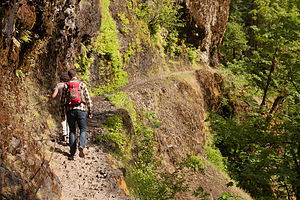 Hiking the Eagle Creek Trail carved into the CliffThe dramatic beauty of its colorful basalt cliffs, cascading waterfalls, and snow-covered volcanic peaks makes for a very scenic drive.
Hiking the Eagle Creek Trail carved into the CliffThe dramatic beauty of its colorful basalt cliffs, cascading waterfalls, and snow-covered volcanic peaks makes for a very scenic drive.
Our first stop was the town of Hood River, famous for its very intense winds. The Cascade Mountains have extreme pressure differentials on either side, which creates a wind tunnel effect and steady winds of over 35 mph. The consistency and strength of these winds makes it an extremely popular destination for kiteboarders and windsurfers.
We got a taste of these strong winds first hand when I opened the RV door in the Hood River Visitor Center parking lot and it flew right out of my hand smashing the little plastic latch that normally locks it in place when it is open. Fortunately, Tommy’s car was parked just far enough away from the motorhome to not smash it when his door flew out of his hands as well. They weren’t kidding about this place being windy.
We thought for sure we would see dozens of kiteboarders out on the river taking advantage of this wind, but so far there were none. The girl in the Visitor Center said they were probably waiting for the winds to build up later in the day – wow! they were already pretty scary.
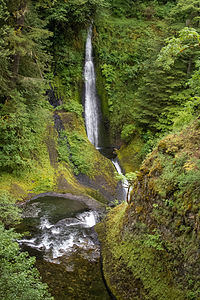 Loowit FallsWe asked for a recommendation for lunch and were directed to the Solstice Wood Fire Café, just across the street from the Hood River,where we had some delicious artisan pizzas.
Loowit FallsWe asked for a recommendation for lunch and were directed to the Solstice Wood Fire Café, just across the street from the Hood River,where we had some delicious artisan pizzas.
Still no kiteboarders, so we continued on along I84 West, which traces the river, towards the Cascade Locks Marine Park, where we planned to camp for the night. I chose this campground because it was very close to the Eagle Creek Trailhead, the most popular hike in the Gorge, which we planned to do later that day. Although my calls to the campground went unanswered, I was hoping that they would have a spot for us. I didn’t think it would be too much of a problem as it was mid-week after a very busy holiday weekend.
When we arrived, the Campground Host was not home, so we pulled into the campground and selected a site with a view of the river. We were immediately greeted by Logan, a blond-haired, blue-eyed camper with a colorful shawl draped around his neck. He was extremely friendly, and told us that the hosts were shopping in town and would be back later. He even offered to let us park our extra car in his site, as he didn’t have one. Logan was a very new age, spiritual kind of guy who seemed very high on life, and other things as well. He told us that this was his lucky day, because he had left his iPad charging in the bathroom and it was stolen. I think we were looking fairly perplexed as to how this theft of an iPad could result in a lucky day, when he cheerfully added that it had been returned to him after he had spent time meditating in his tent and communing with his Native American ancestors. I was about to comment that I had never seen a blond haired, blue eyed Native American, when I thought better of it, and we excused ourselves to go on a hike. I think, if given the chance, he would have talked to us all day.
 Hiking Eagle Creek TrailAfter depositing our campground fee in the self-registration box, we left Logan and headed to the Eagle Creek Trailhead, a short distance away.
Hiking Eagle Creek TrailAfter depositing our campground fee in the self-registration box, we left Logan and headed to the Eagle Creek Trailhead, a short distance away.
The full Eagle Creek hike is a 12-mile out and back to Tunnel Falls. However, since it was already late afternoon, we made it a goal to get as far as High Bridge, making it a 6.4 mile hike. Besides, the description of the entire hike said that we would pass dozens of waterfalls, bubbling streams, and tall basalt cliffs all in the first two miles.
Although we cut the entire hike a little short, we definitely did get a flavor for the beauty of the lush temperate forests and spectacular waterfalls that characterize the Pacific Northwest.
For the first mile or so, the trail took us high above the creek before bringing us deep into a lush old-growth forest. In about a mile and a half, we took a short spur trail for a view of 100-foot Metlako Falls, the tallest along Eagle Creek. Back on the main trail, we walked about another half mile before coming to another spur trail, which led us to Punchbowl Falls, appropriately named for the punchbowl-shaped pool that it cascades into.
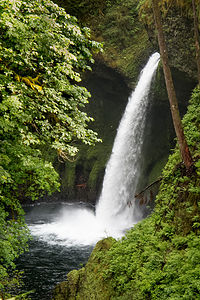 Metlako FallsWe continued on crossing several side creeks, some by hopping on rocks and other by footbridge, before eventually arriving at another impressive waterfall, Loowit Falls, on the opposite side of the creek.
Metlako FallsWe continued on crossing several side creeks, some by hopping on rocks and other by footbridge, before eventually arriving at another impressive waterfall, Loowit Falls, on the opposite side of the creek.
Although most of the hike is relatively flat, with only a 480 feet elevation gain, there are some narrow sections where there are steep drop-offs, especially the approach to High Bridge, where the path is carved into a steep cliffside. Also, the trail is rocky and can be quite slippery when it is wet, which is not uncommon considering this is the Pacific Northwest. However, I didn’t find the trail intimidating at all, and I am not exactly a hero when it comes to heights. Also, in the more precarious sections, you can hold onto cable lines that have been built into the walls.
Then there it was, our goal, the aptly named High Bridge, which dramatically spans a very narrow channel 120 feet high above the creek. We each took our obligatory walk across the bridge, before returning from whence we came. It was a very worthwhile hike indeed.
True to my tendency to, as Herb says, try to stuff 10 pounds into a 5 pound bag, I originally had a second shorter hike planned for the day, but even I recognized how ridiculous that would be, so we returned to the campsite to relax for the remainder of the evening.
The next morning we hopped in Tommy’s car and drove across the Bridge of the Gods to the Washington side of the Gorge and over to the Beacon Rock Trailhead – just 8 miles from our campsite.
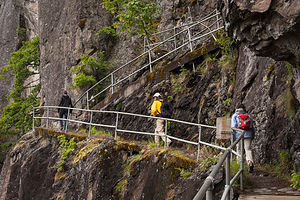 Beacon Rock Hike SwitchbacksI had been intrigued by Beacon Rock when researching things to do on this trip. Besides having what looked like a really cool hike to the top, it had a very interesting history as well, both geologically and culturally.
Beacon Rock Hike SwitchbacksI had been intrigued by Beacon Rock when researching things to do on this trip. Besides having what looked like a really cool hike to the top, it had a very interesting history as well, both geologically and culturally.
Geologically, Beacon Rock is an 848-foot high basalt monolith that was once the core of an ancient volcano about 60,000 years ago.
The Native American called it “Che-Che-op-tin,” which means “navel of the world” – pretty astute considering it was once the belly of a volcano. Lewis and Clark saw it on their journey west and named it Beaten Rock before later changing it to its current name of Beacon Rock.
When the white man came along, they figured they had to own it. It was first purchased by a pioneer in 1850 and it exchanged hands several times before Henry Biddle, editor of the Lewis and Clark Journals, bought it for $1 in 1915 for the purpose of preserving it and building a trail to its summit. Just in time too, because the U.S. Army Corps of Engineers were already removing parts of this rock to use as material to build a jetty at the mouth of the Columbia River. In fact, they had already dug three caves on its south side.
 Beacon Rock HikeBiddle was intrigued by the idea of building a trail to the summit in what he thought was “perhaps the most difficult location in which a trail had ever been built.” The trail took three years to build.
Beacon Rock HikeBiddle was intrigued by the idea of building a trail to the summit in what he thought was “perhaps the most difficult location in which a trail had ever been built.” The trail took three years to build.
I must say, he did a great job and it was a lot of fun. The trail is a little less than a mile long, yet it has 51 switchbacks that zizzag to the top. It’s very well-constructed, with boardwalk bridges and plenty of handrails to hold onto. From the top, we enjoyed expansive views of the gorge and its cliffs, as well as Mt. Hood and Mt. Adams.
One last interesting historical fact. When Biddle tried to gift the rock to the state of Washington to make it into a state park, they refused it and only accepted it when Oregon offered to take it. So, today it is part of the Washington State Park system.
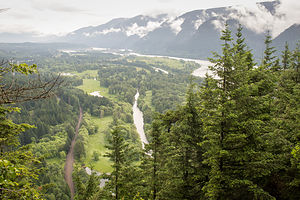 View from Beacon RockAfter the hike, we returned to the campground to pick up the RV and continue west along I84 to our next stop—Multnomah Falls, the tallest falls and most visited attraction in Oregon. There is a large parking lot just off I84 at Exit 31 that can accommodate RVs. We were a little disconcerted by all the signage warning of frequent thefts and the need to not leave valuables in your vehicle. There was even a warning sign next to the Visitor Center that was literally chained down, as if crime was so bad that even the sign would be stolen if not chained down. I don’t understand how or why theft is such a problem here.
View from Beacon RockAfter the hike, we returned to the campground to pick up the RV and continue west along I84 to our next stop—Multnomah Falls, the tallest falls and most visited attraction in Oregon. There is a large parking lot just off I84 at Exit 31 that can accommodate RVs. We were a little disconcerted by all the signage warning of frequent thefts and the need to not leave valuables in your vehicle. There was even a warning sign next to the Visitor Center that was literally chained down, as if crime was so bad that even the sign would be stolen if not chained down. I don’t understand how or why theft is such a problem here.
All this talk of theft made us kind of want to cut our visit short, so instead of taking the short paved footpath up to the Benson Bridge as I would normally have liked to do, we just walked to the lower falls viewpoint and took photos of the bridge with the falls in the background.
I must say though that the lovely, two-tiered falls are very impressive and well worth the stop.
 Lolo and Boys at Beacon Rock SummitI did take time to read a plaque which told of an interesting incident which occurred on the Bridge in the 1990s. As a wedding party was posing for photos, a 400-ton boulder broke off the face of the waterfall and fell 225 feet into the upper cascade pool causing a 70 foot wave of water to wash over the bridge. Fortunately, no one was severely hurt. I hope the photographer got a picture of that scene, but if not, I am sure they will never forget it.
Lolo and Boys at Beacon Rock SummitI did take time to read a plaque which told of an interesting incident which occurred on the Bridge in the 1990s. As a wedding party was posing for photos, a 400-ton boulder broke off the face of the waterfall and fell 225 feet into the upper cascade pool causing a 70 foot wave of water to wash over the bridge. Fortunately, no one was severely hurt. I hope the photographer got a picture of that scene, but if not, I am sure they will never forget it.
We briefly stopped in the historic Multnomah Falls Lodge, long enough for me to see that there was a very warm and cozy dining room that would be a nice place to have lunch or dinner on a future visit.
Originally, I wanted to make one more stop at the historic Vista House, but since it is located on the non-RV friendly, twisty Historic Columbia River Highway, it would have required us to take a car and leave the RV behind in the parking lot with all the theft warnings. Neither Herb nor I were comfortable with that, so we decided to forge on to Seattle.
Description
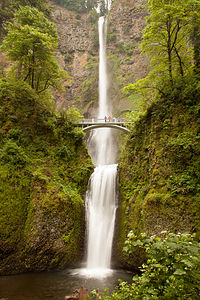 Multnomah FallsThe Columbia River Gorge National Scenic Area encompasses 292,500 acres, running from the mouth of the Deschutes River (east of The Dalles) to the mouth of the Sandy River (near Troutdale, Oregon), spanning southern Washington and northern Oregon.
Multnomah FallsThe Columbia River Gorge National Scenic Area encompasses 292,500 acres, running from the mouth of the Deschutes River (east of The Dalles) to the mouth of the Sandy River (near Troutdale, Oregon), spanning southern Washington and northern Oregon.
In those 80 miles, the Gorge transitions from a temperate rainforest in the west, with an average of 100 inches of precipitation per year, to dry grasslands, where the annual precipitation is less than 15 inches. This drastic change in climate is caused by the Cascade Mountains, which the Gorge passes through. Clouds drop their moisture on the western side of the range, leaving the eastern slopes drier and sunnier.
The Cascade Mountains are also responsible for the extreme atmospheric pressure differentials on either side, which create a wind tunnel effect in the gorge, resulting in winds in excess of 35 mph. This makes the Gorge an extremely popular destination for kiteboarders and windsurfers, especially in the Hood River area.
 Herb and Lolo at Solstice Wood Fire CaféGeologically, the Columbia River is older than the dramatic gorge which rises above it. Towards the end of the last Ice Age, about 12,000 years ago, huge glacial ice dams, in what is now Montana, burst and sent floodwaters, as high as 1,200 feet, rushing down the Columbia River. Rock and ice carried by the rushing waters carved out the sides of the once gently sloping valley, leaving behind the steep-walled, mile-wide gorge we see today.
Herb and Lolo at Solstice Wood Fire CaféGeologically, the Columbia River is older than the dramatic gorge which rises above it. Towards the end of the last Ice Age, about 12,000 years ago, huge glacial ice dams, in what is now Montana, burst and sent floodwaters, as high as 1,200 feet, rushing down the Columbia River. Rock and ice carried by the rushing waters carved out the sides of the once gently sloping valley, leaving behind the steep-walled, mile-wide gorge we see today.
The dramatic beauty of its colorful basalt cliffs, diaphanous waterfalls, and the snow-covered volcanic peaks of Mt. Hood and Mt. Adams flanking its shores makes the Columbia River Gorge a popular year-round destination for outdoor enthusiasts who come to hike, mountain bike, rock climb, and windsurf in this truly unique area.
Today, the Columbia River serves as the border between Washington and Oregon. Highways in both states trace the river, with many scenic stops along the way. The following is a brief list of highlights along the way (from west to east):
Washington side (Highway 14):
- Cape Horn Viewpoint – panorama of the Gorge from atop the basalt cliffs rising hundreds of feet above the river
- Beacon Rock – 848-foot high basalt monolith, which is the core of an ancient volcano. There is a steep, zigzagging 1-mile trail to the summit (with handrails) with expansive views of the gorge and its cliffs, as well as Mt. Hood and Mt. Adams.
- Bonneville Hot Springs Resort
- Stevenson – old lumbering town that now has a two-hour cruise on a 600-foot stern-wheeler.
- Home Valley Park – great spot for fishermen, windsurfers, and picnickers. From here there is a great view of the Guardians of the Gorge, Wind Mountain in Washington and Shellrock Mountain in Oregon.
- Roadside Park – you have now left the lush, forested section of the gorge and entered the dry grasslands of the eastern side of the Cascades. There are excellent views of the gorge from this park.
- The Dalles Lock and Dam – another hydroelectric plant along the gorge. Visitors can take a shuttle to the powerhouse, fish ladders, and petroglyphs that were moved here for display. Scanning the sky for bald eagles is also popular along the shoreline of Lake Celilo, a 24-mile reservoir formed by the dam.
- Maryhill Museum of Art - small, very eclectic art museum situated atop a remote bluff overlooking the Columbia River Gorge in the town of Maryhill, Washington
- Maryhill Stonehenge - full-size replica of Stonehenge in England, built in 1918 as a memorial to the soldiers of Klickitat County, Washington, who had died in World War I.
Oregon side (I84 and Historic Columbia River Highway):
Both I84 and the Historic Columbia River Highway trace the Oregon side of the river. Although I84 is the fastest road, the Historic Highway is much more scenic. However, it is not recommended for RVs or trailers.
The first three stops can only be reached via the Historic Highway.
- Portland Women’s Forum State Scenic Viewpoint
- Vista House – stands 733 feet above the river on Crown Point, the Vista House is one of the most photographed spots in the Gorge. The views of the Gorge and the Cascade Mountains are phenomenal.
- From Crown Point, the historic highway drops back down into the Gorge past several picturesque and easily accessible waterfalls: Latourell Falls, Shepherd’s Dell Falls, Bridal Veil Falls, Mist Falls, and Wahkeena Falls
- Multnomah Falls – 621-foot high Multnomah Falls is the tallest falls in Oregon and the most visited natural attraction in the state. The ribbon-like upper falls drops 542 feet into a deep pool before flowing another 69-feet in its lower tier. A short, paved footpath leads up to Benson Bridge, which spans 25 feet above the lower tier.
- Bonneville Lock and Dam - nation’s largest hydroelectric plant, where there was a visitor center with exhibits on the history of the dam. Fish ladders and an underwater fish viewing window allows visitors close-up glimpses of migrating salmon swimming upriver to spawn.
- Bonneville Fish Hatchery - The hatchery raises 8 million Fall Chinook, 1.2 million Coho, 200 thousand Summer Steelhead, and 60 thousand Winter Steelhead. However, it's most famous resident is Herman, the 70-year-old, 10-foot long, 450 pound sturgeon.
- Eagle Creek Trail – this relatively flat hike, which leads through a lush rain forest, past dozens of spectacular waterfalls and basalt cliffs, is one of the most popular in the Columbia River Gorge
- Bridge of the Gods – connects Washington and Oregon
- Cascade Locks – this stop is a bit of a misnomer today. This section of the river was once a raging torrent that required boaters to portage around. In 1896, the Cascade Locks were built to allow steamships to pass safely. With the construction of the Bonneville Lock and Dam, the cascades were flooded and the locks became superfluous.
- Rooster Rock State Park – the most prominent feature of the park is a basalt column that forms a natural obelisk. Lewis and Clark camped near this rock in 1805, and named it “Cock Rock” because of its phallic shape. The name was later changed to the more politically correct “Rooster Rock.” The park also has long sandy beach for swimming.
- Hood River – once a lumber town, Hood River is now known for its fruit orchards and as a mecca for windsurfers and kiteboarders, who come to take advantage of this natural wind tunnel
- Columbia Gorge Discovery Center in The Dalles – serves as the eastern gateway to the Columbia Gorge. The museum as exhibits on the geology and history of the Gorge.
- ‹ previous
- 5 of 9
- next ›
Columbia River Gorge National Scenic Area location map in "high definition"
Javascript is required to view this map.
